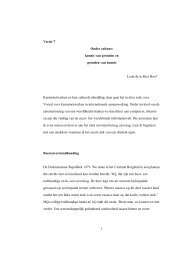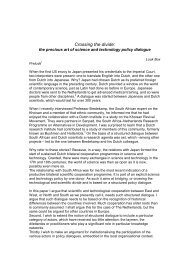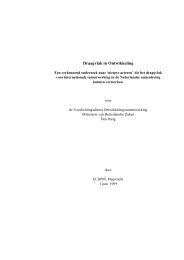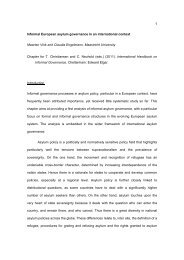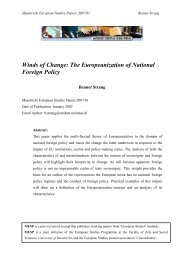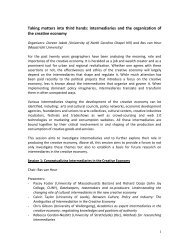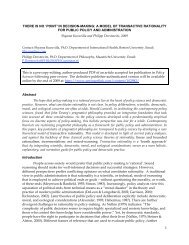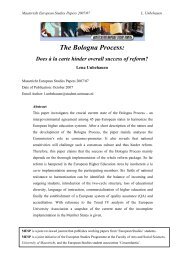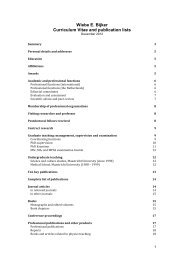the case of the synthetic dye industry, 1857–1914 - Maastricht ...
the case of the synthetic dye industry, 1857–1914 - Maastricht ...
the case of the synthetic dye industry, 1857–1914 - Maastricht ...
Create successful ePaper yourself
Turn your PDF publications into a flip-book with our unique Google optimized e-Paper software.
Comparing evolutionary dynamics across different national settings 189<br />
that being a high-tech <strong>industry</strong> is not sufficient to cause a quick shake-out. Social<br />
context matters too, as we describe in more detail below.<br />
Relatively small fluctuations in Britain<br />
The British pattern in <strong>the</strong> early years <strong>of</strong> <strong>the</strong> syn<strong>the</strong>tic <strong>dye</strong> <strong>industry</strong> resembles more<br />
<strong>the</strong> S-shaped curve that has been found in studies <strong>of</strong> diffusion <strong>of</strong> innovations,<br />
diseases, or fashions. The entry slope for Britain is not as steep as that <strong>of</strong> France.<br />
Britain, with a peak <strong>of</strong> 16 firms, never reached <strong>the</strong> <strong>industry</strong> participation level <strong>of</strong><br />
France. The period <strong>of</strong> rapid growth took place from 1859 to 1863. Britain also<br />
experienced a decline <strong>of</strong> syn<strong>the</strong>tic <strong>dye</strong> firms from 1864 to 1866, but <strong>the</strong> decline<br />
was not nearly as dramatic as in <strong>the</strong> <strong>case</strong> <strong>of</strong> France, where one can truly speak<br />
<strong>of</strong> a shakeout. Existing historiography emphasizes that Britain was <strong>the</strong> leading<br />
country in <strong>the</strong> early syn<strong>the</strong>tic <strong>dye</strong> <strong>industry</strong>, with France closely following and<br />
Germany far behind (Beer, 1959; Travis, 1993). Our data show, however, that<br />
France was not trailing at all. These findings call for a reevaluation <strong>of</strong> <strong>the</strong> early<br />
period in <strong>the</strong> syn<strong>the</strong>tic <strong>dye</strong> <strong>industry</strong> (see Fig. 3). Growth in France was earlier<br />
and quicker, and more firms participated in <strong>the</strong> French <strong>industry</strong> in <strong>the</strong> very early<br />
years. Figure 4, which plots <strong>the</strong> fraction <strong>of</strong> <strong>the</strong> global firm population that resided<br />
in each <strong>of</strong> <strong>the</strong> five major countries in a given year, makes this point forcefully.<br />
Already in 1858 <strong>the</strong> French share in <strong>the</strong> global firm population surpassed <strong>the</strong><br />
British share, and until 1870 <strong>the</strong> number <strong>of</strong> syn<strong>the</strong>tic <strong>dye</strong> firms in Britain was<br />
lower than in France. The British <strong>industry</strong> reached <strong>the</strong> lowest (relative) level<br />
in <strong>the</strong> number <strong>of</strong> firms in 1864. From 1864 to 1914 <strong>the</strong> number <strong>of</strong> <strong>industry</strong><br />
participants remained fairly constant in Britain. The British <strong>industry</strong> stabilized<br />
earlier than <strong>the</strong> French, but it is striking how <strong>the</strong> levels <strong>of</strong> <strong>industry</strong> participation<br />
became similar in <strong>the</strong> two countries from <strong>the</strong> 1870s onward, with Britain having<br />
a slightly larger number <strong>of</strong> firms than France.<br />
Germany: Long rise in <strong>the</strong> number <strong>of</strong> firms<br />
Germany also displays a steep rise in <strong>the</strong> number <strong>of</strong> firms between 1858 and<br />
1863. The number increased from 2 firms in 1858 to about 22 in 1863. Existing<br />
historiography does not discuss this early entry <strong>of</strong> a large number <strong>of</strong> firms<br />
in Germany, in part because <strong>the</strong>se early German entrants did not possess <strong>the</strong><br />
visibility <strong>of</strong> <strong>the</strong> leading British and French firms during this period. The timing<br />
<strong>of</strong> <strong>the</strong> German rise is about <strong>the</strong> same as in France, but Germany began at a<br />
lower level in 1858. The striking difference between Germany, on <strong>the</strong> one hand,<br />
and Britain and France, on <strong>the</strong> o<strong>the</strong>r, is that <strong>the</strong> number <strong>of</strong> firms in Germany<br />
continued to increase after 1863. The lasting growth in <strong>the</strong> number <strong>of</strong> German<br />
firms is <strong>the</strong> reason <strong>the</strong> dramatic shakeout that occurred in France does not show<br />
up at <strong>the</strong> global level. After a short consolidation phase (1873-76), <strong>the</strong> growth<br />
continued from 1877 to 1897. In this period <strong>the</strong> number <strong>of</strong> firms increased as<br />
a step function, alternating between periods <strong>of</strong> rapid growth and stabilization,



